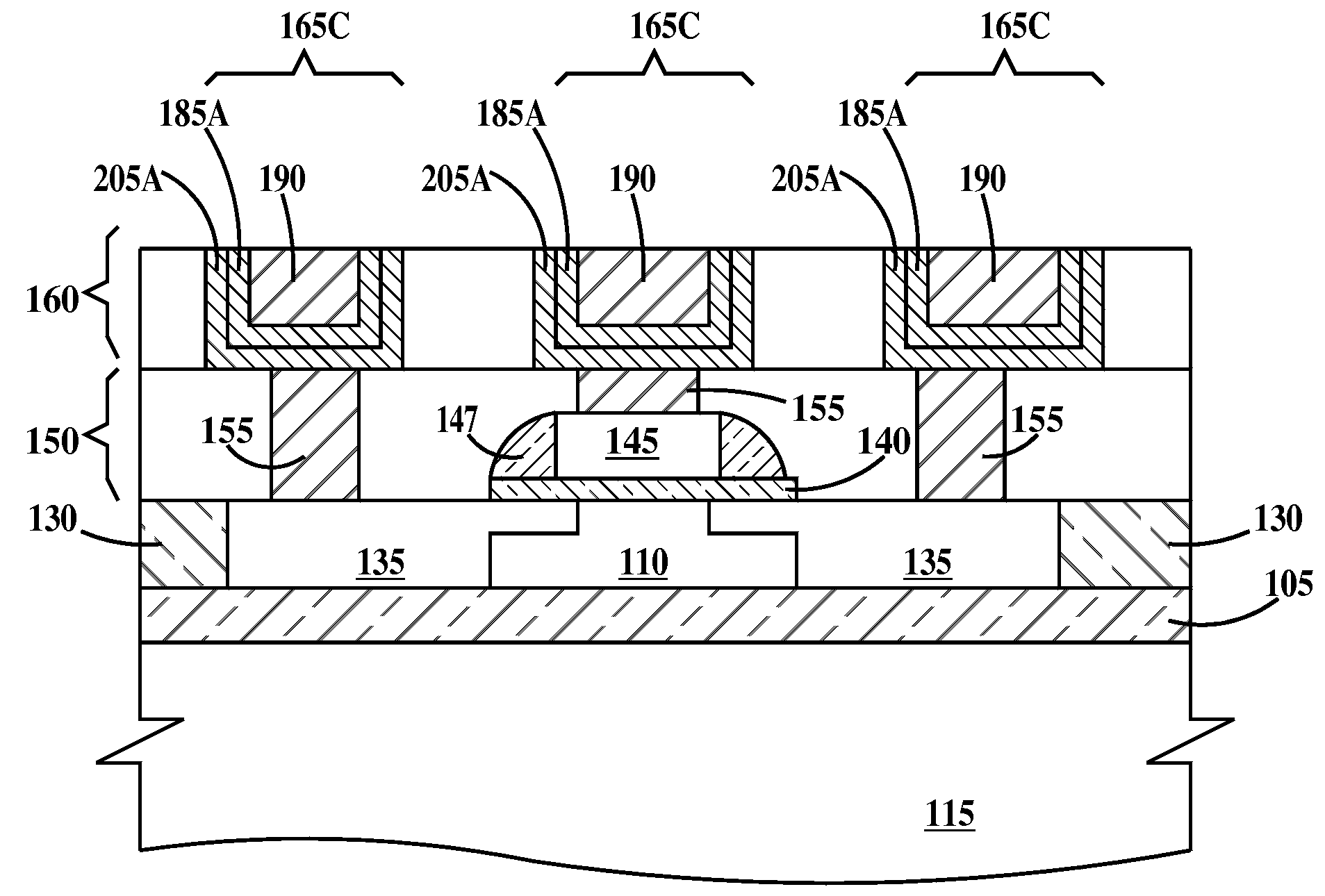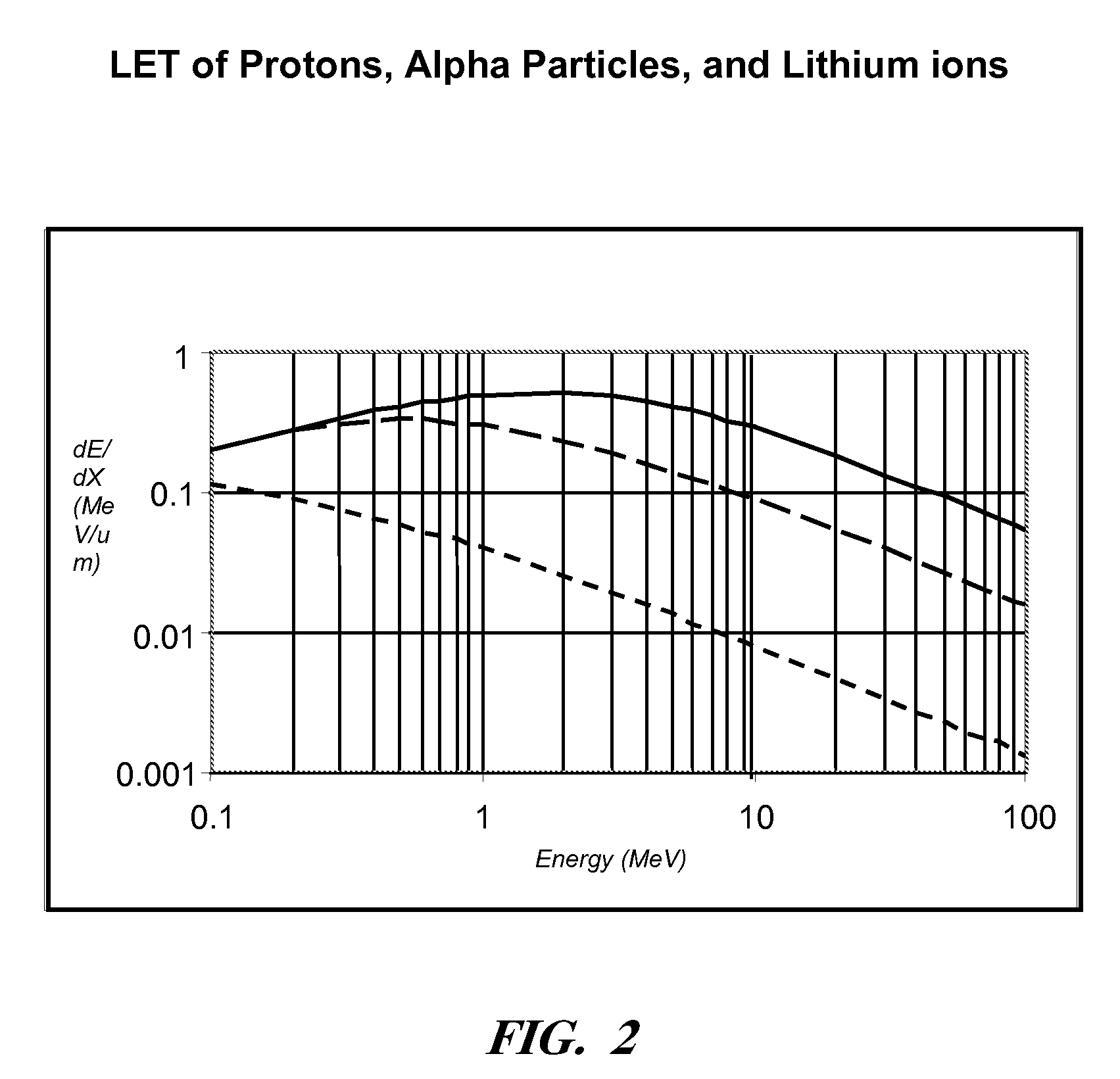Method and structures for accelerated soft-error testing
a technology of integrated circuits and methods, applied in the field of integrated circuits, can solve problems such as disposal problems, generation of errors, contamination of manufacturing and testing facilities,
- Summary
- Abstract
- Description
- Claims
- Application Information
AI Technical Summary
Benefits of technology
Problems solved by technology
Method used
Image
Examples
first embodiment
[0019]FIGS. 3A and 3B are cross-sectional drawings illustrating the present invention. In FIG. 3A, a silicon-on-insulator (SOI) substrate 100 comprises a buried oxide layer (BOX) 105 between an upper single-crystal silicon layer 110 and a supporting substrate 115. In one example, supporting substrate 115 is comprises silicon or single-crystal silicon. Substrate 100 is subjected to an ion implantation of 10B or 6Li ions 120 or both 10B and 6Li ions, which form an alpha particle emitting layer 125 in supporting substrate 115. The center of alpha emitting layer 125 is located a distance D from a top surface 127 of substrate 100. D is chosen such that, after all the heat cycles that substrate 100 is subjected to during fabrication of integrated circuits, alpha particle emitting layer 125 is close enough to upper silicon layer 110 for alpha particles emitted when the 10B or 6Li is struck by thermal neutrons to have range greater than the distance between the alpha particle layer and top ...
second embodiment
[0027]FIG. 4 is a cross-sectional drawing illustrating the present invention. FIG. 4 is similar to FIG. 3B except alpha particle emitting layer 125 has not been formed and the processing is shown after completion of wire formation in first ILD layer 160. In FIG. 4, first ILD layer 160 is subjected to the ion implantation of 10B or 6Li ions 120 or both 10B and 6Li ions, which form an alpha particle emitting layer 170 in ILD layer 160 and wires 165. Optionally, a patterned ion implantation mask may be formed over first ILD layer 160 to block ion-implantation of 10B or / and 6Li into certain wires 165 and regions of the first ILD layer. Since there are very few high temperature heat cycles after formation of first ILD layer 160, the 10B or / and 6Li will stay mainly within first ILD 160 and wires 165. After the ion implantation, additional ILD layers and wires may be formed to complete the integrated circuit chips.
[0028]When and integrated circuit chip containing alpha particle emitting la...
third embodiment
[0029]FIGS. 5A through 5C are cross-sectional drawing illustrating the present invention. FIG. 5A is similar to FIG. 3B up to formation of ILD layer 160. In FIG. 5A, trenches 175 are formed in ILD layer 160 and an electrically conductive conformal layer 180 is formed on the sidewalls and bottoms of trenches 175 and the top surface of ILD layer 160. Conformal layer 180 may be formed, for example, by sputter deposition. In one example, conformal layer 180 comprises, tantalum (Ta), tantalum nitride (TaN), titanium (Ti), titanium nitride (TiN) or combinations thereof. Alternatively, conformal layer 180 may be formed by chemical-vapor deposition (CVD).
[0030]In FIG. 5B a conformal doped seed layer 185 comprising copper (Cu) and 10B, Cu and 6Li or Cu, 10B and 6Li is formed by sputter deposition from a target comprised of Cu and 10B and / or 6Li. In sputter deposition, ions (e.g., argon ions) are directed to a target in vacuum chamber and particles of the target are ejected from the target by...
PUM
 Login to View More
Login to View More Abstract
Description
Claims
Application Information
 Login to View More
Login to View More - R&D
- Intellectual Property
- Life Sciences
- Materials
- Tech Scout
- Unparalleled Data Quality
- Higher Quality Content
- 60% Fewer Hallucinations
Browse by: Latest US Patents, China's latest patents, Technical Efficacy Thesaurus, Application Domain, Technology Topic, Popular Technical Reports.
© 2025 PatSnap. All rights reserved.Legal|Privacy policy|Modern Slavery Act Transparency Statement|Sitemap|About US| Contact US: help@patsnap.com



